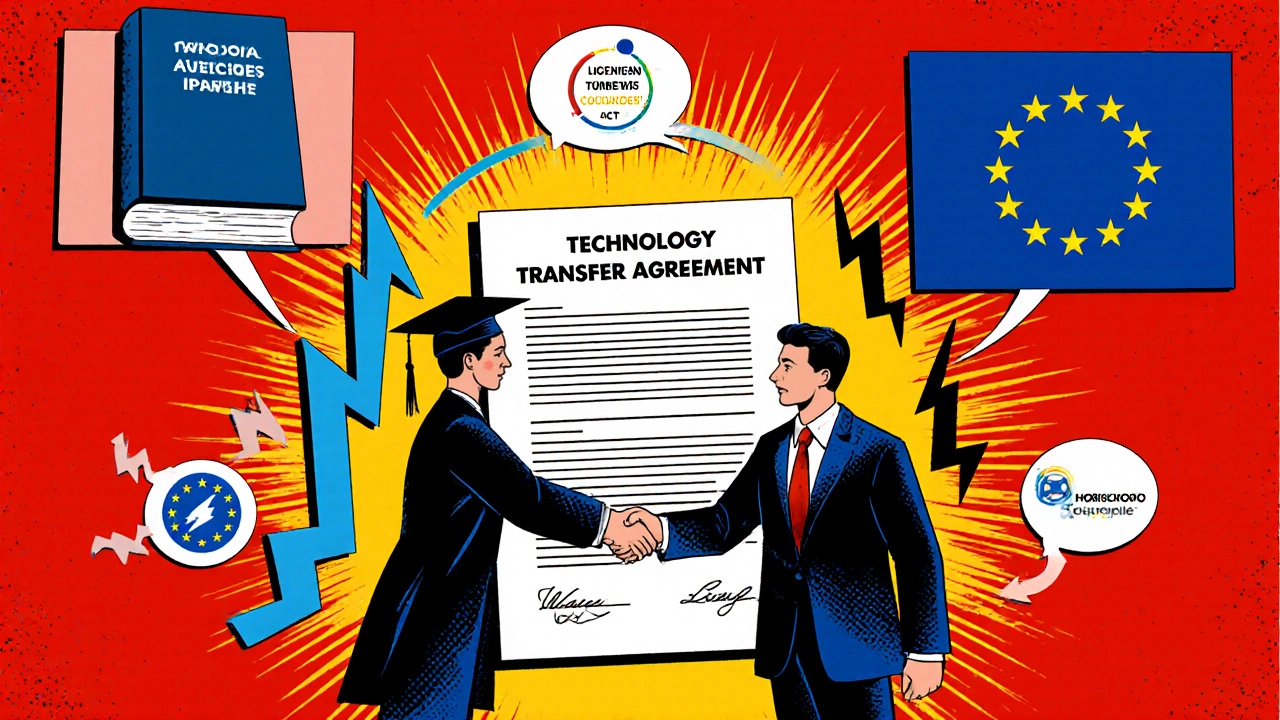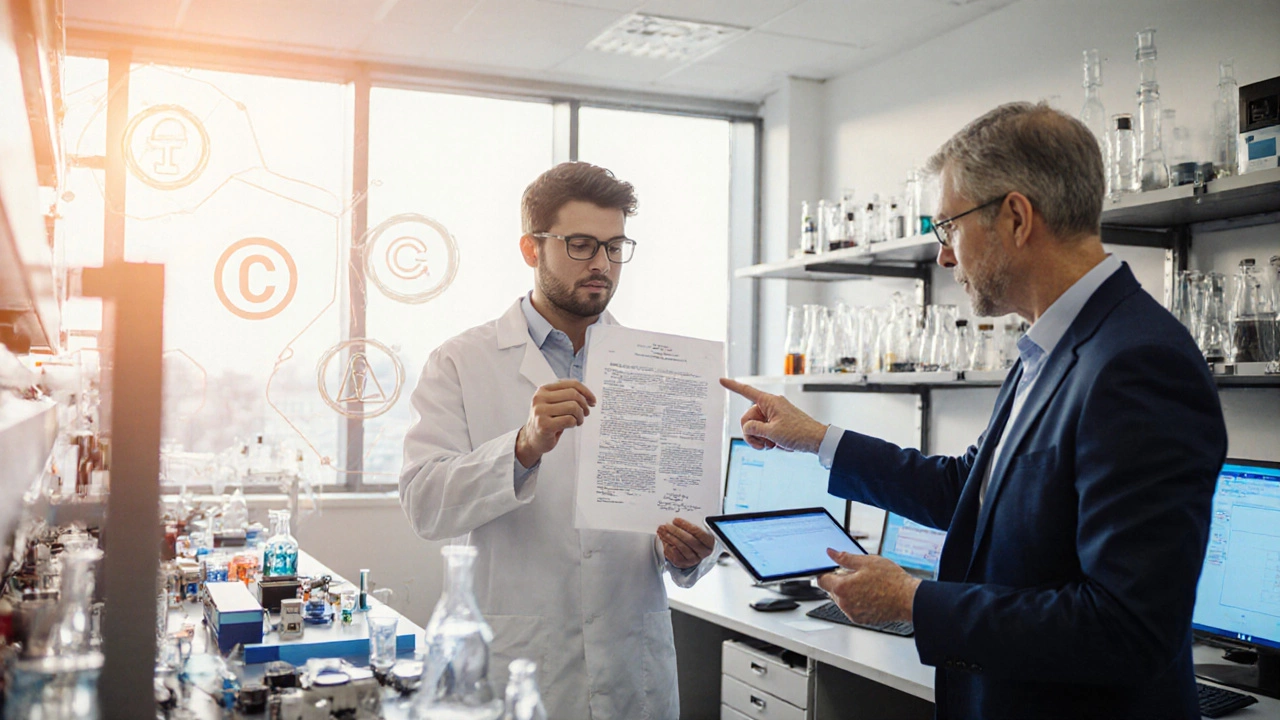Technology Transfer Compliance Risk Calculator
Compliance Risk Assessment
This calculator helps identify potential compliance risks when transferring technology internationally. Enter your scenario details to receive a risk assessment and recommendations.
When universities, labs, or startups talk about moving a discovery from the lab to the market, the phrase technology transfer definition pops up, but the legal meaning often stays fuzzy. Understanding the exact legal definition helps researchers draft agreements, protects intellectual property, and keeps the whole process compliant with national and international rules.
Quick Takeaways
- Legally, technology transfer is the conveyance of know‑how, patents, or other IP from a research entity to a commercial party under a binding contract.
- Key elements include ownership rights, licensing terms, confidentiality, and compliance with applicable statutes such as the Bayh‑Dole Act.
- Common mechanisms are licensing, spin‑offs, joint ventures, and research‑service agreements.
- Stakeholders-universities, firms, government agencies-each have distinct responsibilities and risk‑areas.
- Typical pitfalls involve ambiguous IP scope, breach of export controls, and neglecting royalty reporting.
Technology Transfer is the legally‑structured movement of scientific knowledge, inventions, or processes from a research‑producing organization to a commercial entity for development, manufacturing, or marketing. This definition hinges on three pillars: the asset (usually protected by Intellectual Propertylegal rights that guard creations, ranging from patents to trade secrets, the contractual framework, and the governing law.
Legal Framework Overview
Most countries embed technology transfer in a mix of statutory law, university policies, and international agreements. In the United States, the Bayh‑Dole Act (1980) granted universities the right to own patents arising from federally funded research, turning them into active players in the market. In Europe, the European Commission’s Horizon Europe guidelines push for open‑access results while still allowing exclusive licensing under defined conditions.
Key international standards include the WTO’s TRIPS Agreement, which sets baseline IP protection, and the UNESCO Recommendation on Science and Technology Policy that encourages transparent transfer practices. These layers ensure that a transfer isn’t just a friendly handshake-it’s a contract enforceable in court.

Core Elements of the Legal Definition
Across jurisdictions, the law looks for the following attributes to deem a transaction a legitimate technology transfer:
- Asset Identification: The specific invention, know‑how, or data being transferred must be clearly defined, often via a patent number, a copyright registration, or a detailed description of trade secrets.
- Ownership Confirmation: The transferring party must hold legal title or an exclusive right to the asset. This is why Patentgrants the holder exclusive rights to make, use, and sell an invention for a set period ownership is a prerequisite.
- Licensing Terms: The agreement outlines whether the license is exclusive, non‑exclusive, field‑of‑use restricted, or time‑limited. It also sets royalty rates, milestones, and reporting obligations.
- Confidentiality and Know‑How Protection: When the asset includes undisclosed technical information, a Confidentiality Agreementprotects trade secrets from public disclosure is embedded.
- Compliance Clauses: Export controls, antitrust considerations, and government‑funded research reporting (e.g., Bayh‑Dole Actrequires royalty reporting and preference for U.S. industry) are mandatory.
Key Legislation and Policies
Below are the most referenced legal sources that shape technology transfer practice around the globe:
- Bayh‑Dole Act (U.S.): Empowers universities to own and license federally funded inventions, mandates preferential licensing to U.S. small businesses, and requires royalty sharing with inventors.
- TRIPS Agreement (WTO): Sets minimum standards for IP protection, influencing how patents and copyrights are treated in transfer contracts.
- EU Horizon Europe Guidelines: Require open‑access publication of research outcomes, but allow exclusive licensing for certain high‑risk, high‑cost developments.
- UNESCO Recommendation (2022): Encourages transparent, benefit‑sharing mechanisms for technology transfers, especially in developing economies.
- National Export Control Laws: In India, the SCOMET guidelines govern the export of dual‑use technologies, impacting cross‑border licensing.
Common Transfer Mechanisms
While the legal definition stays constant, the way assets move varies. The four most popular mechanisms are:
| Mechanism | Typical Use‑Case | Control Level | Revenue Model |
|---|---|---|---|
| Licensing | Existing patent or know‑how licensed to an established firm | High - contract‑defined rights | Royalties, milestone payments |
| Spin‑off Company | Researchers form a new company to commercialize a breakthrough | Very high - founders retain equity | Equity, exits, licensing back to third parties |
| Joint Venture | Two or more parties share development risk on a large‑scale project | Medium - shared governance | Profit sharing, cost recovery |
| Research‑Service Agreement | Industry funds a university lab for a specific deliverable | Low to medium - IP often co‑owned | Fixed fees, possible future licensing |
Choosing the right mechanism depends on the maturity of the technology, the risk appetite of the parties, and regulatory constraints.

Stakeholder Roles and Responsibilities
Research Institutionsuniversities, national labs, or NGOs that generate new knowledge typically own the primary IP but delegate commercialization to a Technology Transfer Office (TTO). The TTO drafts agreements, evaluates market potential, and ensures compliance with funding agency rules.
Corporate R&Dprivate‑sector labs that seek external innovations to accelerate product pipelines act as licensees or spin‑off partners. They must conduct due diligence on IP validity and freedom‑to‑operate.
Government agencies, through Government Policylegislation, grants, and oversight bodies that shape transfer practices, enforce reporting, set royalty caps, and may retain a “march‑in” right for public interest.
Inventors themselves retain moral rights under many jurisdictions. They often receive a share of royalties or equity, especially under Bayh‑Dole‑type frameworks.
Pitfalls and Compliance Tips
Even seasoned tech‑transfer professionals stumble over common traps. Here are practical guardrails:
- Vague IP Scope: Avoid generic language like “all related technologies.” List patent numbers, claim numbers, and specific trade‑secret descriptions.
- Missing Export‑Control Checks: Before signing a cross‑border license, verify that the technology isn’t listed on national control lists (e.g., India’s SCOMET). Failure can lead to heavy fines.
- Improper Royalty Reporting: Bayh‑Dole and similar statutes demand annual reports. Set up automated tracking to stay compliant.
- Antitrust Red Flags: Exclusive licenses in markets with few competitors may attract scrutiny. Include “most‑favored‑nation” clauses as a safeguard.
- Neglected Confidentiality: When transferring know‑how, embed a robust confidentiality clause with clear duration and breach penalties.
Regularly review agreements with legal counsel familiar with both IP law and the specific sector-biotech, clean tech, or AI each have nuances.
Frequently Asked Questions
What exactly qualifies as "technology" in a legal transfer?
Legally, "technology" covers any protectable intellectual asset-patents, copyrights, trademarks, trade secrets, software code, or even validated processes-provided there is clear ownership and a defined scope in the agreement.
Does the Bayh‑Dole Act apply outside the United States?
No. Bayh‑Dole is U.S. legislation. However, many countries have adopted similar university‑ownership rules-e.g., Canada’s “Tri‑Agency” policy and the EU’s Framework Programme guidelines-so the concept exists globally, just under different statutes.
Can a technology transfer be non‑exclusive?
Absolutely. A non‑exclusive license allows the licensor to grant the same rights to multiple parties. This model is common for software platforms or low‑margin manufacturing processes.
What reporting obligations do universities have after a license is signed?
Under Bayh‑Dole, U.S. institutions must file annual reports on royalties received, disclose any income spinoff, and ensure that inventions are commercialized within a reasonable timeframe (typically three years).
How does export control affect technology transfer?
If the technology is listed on a national control list, the transfer may require an export license. Ignoring this can lead to criminal penalties, seizure of assets, and loss of future funding.




